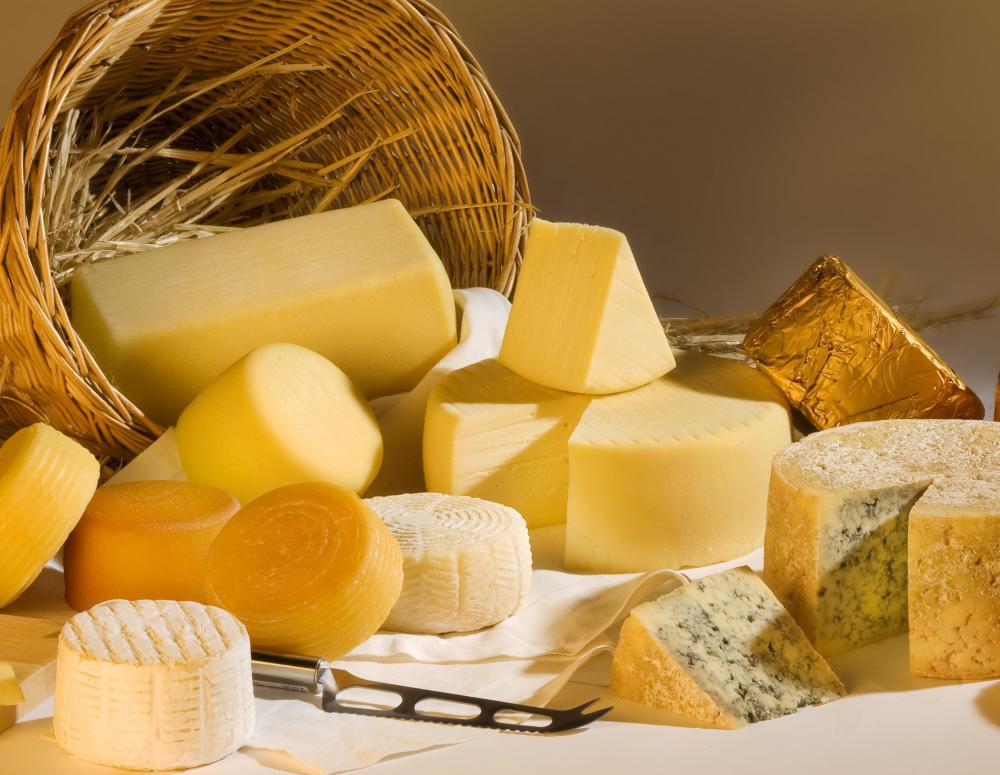At WiseGEEK, we're committed to delivering accurate, trustworthy information. Our expert-authored content is rigorously fact-checked and sourced from credible authorities. Discover how we uphold the highest standards in providing you with reliable knowledge.
What Are the Best Tips for Using Colby Cheese?
The best tips for using Colby cheese include shredding or cubing the cheese before adding it to hot dishes to ensure quick melting without the need for high temperatures. Generally, people serve Colby cheeses as appetizers, to complement pieces of fruit or crackers, or to add flavor to salads. Colby cheese is not as solid as some other cheeses and has high moisture content, so a person should refrigerate it properly to prevent mold growth.
In 1874, Joseph Steinward of Colby, Wisconsin, created Colby cheese as a mild, almost bland, table cheese. To add more flavors to the cheese, some cheese makers add seasonings and other ingredients, such as hot peppers or certain meats. Its mild taste might complement some hot dishes, such as grilled cheese sandwiches and cheese soups, but high temperatures can toughen the cheese and make it stringy.

One of the best tips for using Colby cheese is to store it correctly. A consumer should keep the cheese refrigerated and tightly wrapped in plastic or foil. The airtight wrapping has two benefits: it protects the cheese from drying out, and it shields the cheese from airborne contaminates that promote mold growth. Unused cheese can be frozen for as long as six months and thawed slowly in the refrigerator.

Colby has a higher moisture level than cheddar, therefore it might mold quicker if not kept properly. Another factor that causes waste is that most Colby varieties have loose curds, meaning that they are not as solid as most cheddars. Tiny air pockets allow the hyphae, or root-like mold structures, to penetrate deeper into the block of cheese.
Serving cheese at room temperature enhances the flavor and texture. To keep the cheese from spoiling, a hostess should not leave trays of cheese at room temperature for several hours. Most experts recommend no longer than four hours at normal temperatures and less than four hours if the temperatures are high. Exposing Colby cheese to prolonged periods of warm temperatures can cause it to dry out and will leach the oils from the cheese. One tip for serving cheese is to have extra trays of cheese in the refrigerator to extend the serving time without risking serving an inferior product.
Many cheese makers offer different flavors of Colby cheeses. Generally, these cheeses are serving cheeses or table cheeses and are not used in cooking. Many cooks use cubes of the flavored cheeses to enhance a salad. Some of these varieties include co-jack or marble, which is a combination of Colby and Monterey jack cheese. Other specialty Colby flavors are jalapeno or vegetable; meat-enhanced, such as bacon, salami or pepperoni Colby; and others, such as chocolate.
Knowing how to cook with Colby cheese is important. The cheese toughens and becomes stringy when subjected to high heat. One tip for avoiding this situation is to add the cheese as the last ingredient and heat it just to the melting stage. If a cook cuts the cheese into small pieces or shreds it, it will quicken the melting process. For easy shredding, a person can freeze the block of cheese for 30 minutes to firm it.
AS FEATURED ON:
AS FEATURED ON:












Discussion Comments
I used to have an issue of Colby cheese getting wasted because it would grow mold before it was finished. My neighbor told me that he had the same problem with Mozzarella cheese until he figured out how to prevent mold. He said to re-wrap the cheese with a new piece of plastic wrap every time I open and cut out some of the cheese. I took his advice and the Colby hasn't gone bad this time! We finished up all of it!
I guess some mold spores get on the plastic wrap and if it's changed frequently, it doesn't the opportunity to take over the cheese.
I've never used Colby cheese alone in a dish, because it doesn't have much of a flavor. I only use this cheese because it's affordable and it can be used in place of other cheeses when I need three or more different cheeses for a dish. So I've used it alongside Cheddar, American and Mozzarella in macaroni and cheese or casserole.
I use Colby cheese for pasta and sometimes shredded on top of hot dogs.
When I use it for pasta, I cook and drain the pasta and add the cheese right away while the pasta is still hot. I don't run the pasta through cold water. The heat of the pasta warms and softens the cheese without it burning or sticking to the sides of the saucer.
I think when used this way, Colby cheese will work in most hot dishes. The trick is turn the heat off and allow the heat of the cooked food to melt the cheese.
Post your comments